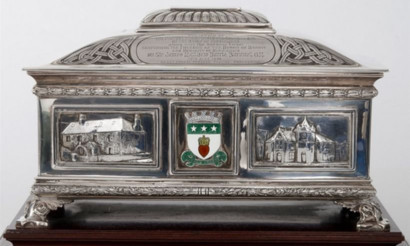A casket that once bore the “heart” of an Angus burgh to its most famous son is the subject of a literary race against time.
Peter Pan creator Sir JM Barrie was given the freedom of his hometown of Kirriemuir in 1930 by then provost Henry Peacock.
After disappearing into a family collection, the casket has appeared “from nowhere” and will be auctioned on August 8, where it is expected to raise £2,000 to £3,000.
Barrie was presented with a silver casket containing what was, according to Mr Peacock, “the heart of Kirriemuir.”
In a rare public appearance on June 7 of that year, Barrie made a speech and even a couple of jokes as he received a “burgess ticket” inside, which conferred the “burgh of barony and regality of Kirriemuir.”
Barrie died less than seven years later, and the casket has been in a private collection since a sale of his effects in 1938.
Now the item will go under the hammer in Taunton, Somerset, and a local historian has said he would love to see the gift to Kirriemuir’s “first freeman” return.
David Orr of the Kirriemuir Heritage Trust told The Courier: “We would dearly love to return the casket to where it belongs.
“I only found out about the auction last week and there’s been dozens of emails and communication about what we should do.
“I’ve been in contact with Angus Council, and think there is something that they can come up with, but it’s early days and the clock is ticking.”
A council spokesperson said: “We are currently investigating this item. We would be delighted if we were successful on behalf of the people of Kirriemuir and Angus.”
Dundee architect Frank Thomson presented Barrie with the keys to a new cricket pavilion before a reformed version of his visiting team, the Allahakbarries, played the town club in front of 5,000 people.
Barrie’s side were named after the mistaken belief that Allah akbar meant heaven help us in Arabic, and membership was a who’s who of Victorian literature HG Wells, Arthur Conan Doyle, Jerome K Jerome, GK Chesterton, AA Milne, and PG Wodehouse all played at some time.
Sir JM Barrie was born in Kirriemuir in 1860 and left when he was 13 before going on to study at Edinburgh University.
He worked for 18 months as a staff journalist on the Nottingham Journal then returned to Angus, using his mother’s stories about Kirrie, which he renamed Thrums, for a piece submitted to the St James’s Gazette in London.
His “Scotch” pieces emerged at a time when the “kailyard” school of tartan writing was becoming a sensation.
A Window in Thrums was published in 1890 among a set of Thrums novels, before Barrie moved into playwriting.
A Mr John Smith of Glasgow bought the casket for £56 at Sotheby’s in London.
